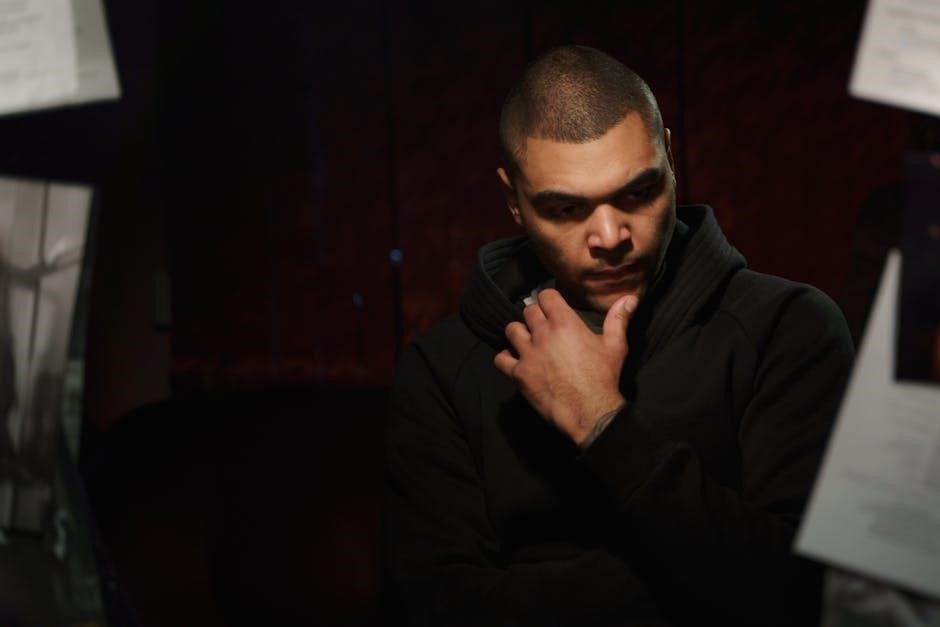A Raisin in the Sun: Character Analysis
A Raisin in the Sun intricately portrays a family’s aspirations amid racial prejudice. The characters‚ each with unique dreams and struggles‚ contribute to the play’s exploration of identity‚ ambition‚ and the pursuit of a better life.
Main Characters
A Raisin in the Sun revolves around the Younger family‚ each member embodying distinct aspirations and grappling with societal constraints. Lena Younger‚ the matriarch‚ holds the family together with her strong moral compass and unwavering faith‚ dreaming of a better future for her children. Walter Lee Younger‚ her son‚ is driven by ambition and a desire for financial independence‚ often clashing with his family’s values.
Beneatha Younger‚ Walter’s sister‚ is a young and intelligent woman searching for her identity and challenging societal norms. Ruth Younger‚ Walter’s wife‚ is a burdened mother and wife‚ striving to maintain her family’s stability amid financial hardship. Travis Younger‚ their son‚ represents innocence and hope for the future‚ symbolizing the family’s dreams for a better tomorrow.
These main characters‚ with their complex relationships and conflicting desires‚ drive the narrative of A Raisin in the Sun‚ exploring themes of family‚ race‚ and the pursuit of the American dream. Their individual journeys intertwine‚ creating a powerful and poignant portrayal of the human condition.
The Younger Family
The Younger family is at the heart of A Raisin in the Sun‚ each member grappling with dreams deferred and societal obstacles. Their interconnected struggles illuminate themes of race‚ class‚ and the pursuit of the American dream.
Lena Younger (Mama): Matriarch and Moral Compass
Lena Younger‚ often referred to as Mama‚ stands as the unwavering matriarch of the Younger family in Lorraine Hansberry’s A Raisin in the Sun. She embodies strength‚ faith‚ and a deep-seated moral compass that guides her family through challenging times. Mama’s character is deeply rooted in her religious beliefs and her unwavering love for her children and grandson. She carries the weight of past hardships‚ including the loss of her husband‚ and is determined to create a better future for her family.
Mama’s dream is to purchase a house where her family can live with dignity and escape the confines of their cramped apartment. She is a symbol of resilience and hope‚ reminding her family of their shared history and the importance of unity. While she deeply loves her children‚ she sometimes struggles to understand their individual aspirations‚ particularly Walter’s ambition and Beneatha’s search for identity.
Her moral center is tested when Walter‚ in his desperation for financial success‚ jeopardizes the family’s future. Despite her disappointment‚ Mama’s love and forgiveness ultimately prevail‚ demonstrating her profound capacity for compassion and her unwavering commitment to her family’s well-being. She is the anchor that keeps the Younger family grounded amidst turmoil.
Walter Lee Younger: Ambition and Frustration
Walter Lee Younger‚ a central figure in A Raisin in the Sun‚ is a complex character driven by ambition and plagued by frustration. He yearns for financial independence and a chance to provide a better life for his family‚ but feels trapped by his circumstances and the limitations imposed upon him by society. Walter works as a chauffeur‚ a job that does not fulfill his aspirations or provide him with the financial means to achieve his dreams.
He sees his father’s life insurance money as an opportunity to escape his current situation and invest in a liquor store‚ believing it to be his path to success and a way to gain respect. Walter’s ambition often clashes with his family’s values‚ particularly his mother’s desire to use the money for a house and Beneatha’s pursuit of education. His frustration manifests in anger‚ resentment‚ and a strained relationship with his wife‚ Ruth;
Walter’s desperation leads him to make questionable decisions‚ and he ultimately loses the money entrusted to him‚ causing immense pain and disappointment to his family. This loss forces him to confront his flaws and re-evaluate his priorities. Through his struggles‚ Walter learns the importance of family‚ pride‚ and standing up for what is right‚ ultimately choosing dignity over financial gain.
Beneatha Younger: Identity and Aspirations
Beneatha Younger‚ Walter’s sister‚ is a young‚ educated woman grappling with her identity and aspirations in A Raisin in the Sun. She represents the changing attitudes of the younger generation‚ particularly regarding race and gender roles. Beneatha is determined to become a doctor‚ a profession that challenges the limited opportunities available to Black women during that time.
She explores her African heritage‚ seeking to connect with her roots and reject the assimilationist pressures of American society. Beneatha experiments with different hairstyles‚ clothing‚ and cultural expressions‚ searching for a sense of belonging and authenticity. Her relationships with Joseph Asagai and George Murchison reflect her internal conflict between embracing her African identity and conforming to societal expectations.
Beneatha is critical of her brother’s materialistic pursuits and traditional views‚ advocating for gender equality and intellectual freedom. She challenges the notion that a woman’s primary role is to marry and have children‚ asserting her right to pursue her own ambitions and define her own identity. Beneatha’s journey is one of self-discovery‚ as she navigates the complexities of race‚ gender‚ and personal fulfillment in a society that often seeks to limit her potential. She emerges as a symbol of hope and progress‚ determined to break barriers and create a better future for herself and others.
Ruth Younger: The Burdened Wife and Mother
Ruth Younger‚ Walter’s wife and Travis’s mother‚ embodies the struggles and sacrifices of a Black woman in 1950s America in A Raisin in the Sun. She is the backbone of the family‚ working tirelessly as a domestic servant to make ends meet and provide for her loved ones. Ruth is worn down by the daily grind of poverty and the emotional strain of her strained marriage with Walter.
She yearns for a better life for her family‚ particularly for her son‚ Travis‚ and sees the potential in Mama’s insurance money to improve their living situation. Ruth is pragmatic and realistic‚ often clashing with Walter’s grandiose dreams and impulsive decisions. She becomes pregnant and considers abortion as a desperate measure to alleviate the financial burden on the family.
Ruth is torn between her love for Walter and her frustration with his immaturity and lack of ambition. She struggles to maintain hope amidst the constant challenges and disappointments‚ clinging to the dream of a brighter future. Ruth’s resilience and unwavering commitment to her family make her a symbol of strength and perseverance in the face of adversity. She represents the countless women who quietly bear the weight of their families’ burdens‚ sacrificing their own desires for the well-being of their loved ones.
Travis Younger: Innocence and Hope for the Future
Travis Younger‚ the ten-year-old son of Walter and Ruth‚ represents innocence and hope for the future in A Raisin in the Sun. He is a sweet‚ impressionable boy who is deeply loved by his family‚ particularly his mother and grandmother. Travis is often caught in the middle of his parents’ marital struggles and the family’s financial difficulties‚ yet he remains optimistic and resilient.
He sleeps on the living room sofa due to the cramped conditions of their apartment‚ highlighting the family’s poverty. Travis’s desire for a simple fifty cents for school demonstrates his innocent wants and the family’s struggle to provide even basic necessities. He looks up to his father‚ Walter‚ despite Walter’s flaws and shortcomings‚ yearning for his attention and approval.
Travis’s presence serves as a constant reminder of the family’s motivation to improve their lives and create a better future for the next generation. He embodies the dreams and aspirations of the Younger family‚ representing the promise of a brighter tomorrow. Travis’s unwavering hope and optimism offer a glimmer of light amidst the darkness and despair that often plague the family. He is a symbol of the enduring power of innocence and the unwavering belief in a better future‚ even in the face of adversity.
Other Significant Characters
Beyond the Younger family‚ A Raisin in the Sun features characters who influence their journey. They represent contrasting ideologies‚ societal pressures‚ and external forces that shape the family’s decisions and highlight the play’s themes.
Joseph Asagai: Beneatha’s Suitor and Advocate for African Identity
Joseph Asagai‚ a Nigerian student and one of Beneatha’s suitors‚ is a vital character in A Raisin in the Sun. He embodies a strong connection to African heritage and intellectualism‚ contrasting sharply with George Murchison’s assimilationist views. Asagai challenges Beneatha to embrace her African roots and question the values of American society.
He represents a sense of pride and identity that Beneatha seeks to understand and incorporate into her own life. Asagai’s influence encourages Beneatha to explore her cultural heritage‚ leading her to adopt a more Afrocentric hairstyle and delve into African studies. He serves as a catalyst for her self-discovery and rejection of societal norms that suppress her true identity.
His relationship with Beneatha is not just romantic but also intellectual‚ as they engage in discussions about race‚ identity‚ and the future of Africa. Asagai’s vision of a liberated and independent Africa inspires Beneatha and offers her a sense of purpose beyond the confines of her immediate circumstances. He invites her to return to Nigeria with him‚ presenting her with an opportunity to connect with her heritage and contribute to the development of her ancestral homeland.
George Murchison: Wealth and Assimilation
George Murchison‚ a wealthy and educated African-American man‚ represents the concept of assimilation in A Raisin in the Sun. He is another of Beneatha’s suitors‚ but his values and beliefs clash with hers‚ highlighting the tension between embracing African heritage and conforming to white American society. George embodies the ideals of the dominant culture‚ prioritizing wealth‚ status‚ and social acceptance.
He is dismissive of Beneatha’s interest in her African roots‚ viewing it as a fleeting fad or a way to be different. George believes that success lies in adopting the customs and values of white America‚ rather than exploring or celebrating African identity. His condescending attitude towards Beneatha’s intellectual pursuits and cultural explorations creates a significant rift between them.
George’s character serves as a foil to Joseph Asagai‚ who encourages Beneatha to embrace her heritage. While Asagai represents a connection to Africa and a rejection of assimilation‚ George embodies the desire to fit into the existing social structure. His presence in the play raises questions about the price of assimilation and the importance of cultural identity. George’s wealth and social standing do not necessarily equate to happiness or fulfillment‚ as he seems to lack a deeper understanding of himself and his place in the world.
Karl Lindner: Representative of Racial Prejudice
Karl Lindner‚ a representative from the Clybourne Park Improvement Association‚ embodies the stark reality of racial prejudice in A Raisin in the Sun. He visits the Younger family to offer them money in exchange for not moving into the predominantly white neighborhood. Lindner’s polite demeanor and seemingly reasonable arguments mask the underlying racism that fuels his actions.
He claims that his community is concerned about the potential for conflict and unhappiness if the Youngers move in‚ suggesting that people are happier when they live among their own kind. Lindner’s words reveal the deep-seated fear and prejudice that exist within the white community‚ highlighting the systemic barriers faced by African Americans seeking to improve their lives. His offer is a clear attempt to maintain segregation and prevent the Youngers from achieving their dream of a better home.
Lindner’s character serves as a catalyst for the Younger family‚ forcing them to confront the reality of racism and decide whether to compromise their principles for financial gain. His presence underscores the challenges faced by African Americans in a society marked by discrimination and inequality. While he attempts to present himself as a reasonable negotiator‚ Lindner’s true motives are rooted in prejudice and a desire to maintain the status quo.
Bobo: Walter’s Associate and a Victim of the Scam
Bobo‚ a minor character in A Raisin in the Sun‚ plays a crucial role in highlighting the devastating consequences of Walter’s ill-fated business venture. He arrives at the Younger apartment bearing the grim news that Willy Harris‚ their supposed partner‚ has run off with all the money‚ including Walter’s investment and the portion earmarked for Beneatha’s education. Bobo’s character represents the vulnerability and desperation of those seeking economic advancement in a society that often denies them opportunities.
His arrival is filled with trepidation as he explains how Willy Harris deceived them. Bobo’s disappointment is not only for himself but also for Walter‚ whom he trusted. He acts as a messenger who unwillingly delivers the crushing blow to the Younger family’s hopes. Bobo’s presence reinforces the play’s themes of dreams deferred and the allure of quick riches that can lead to ruin.
Bobo embodies the tragic consequences of misplaced trust and the harsh realities of the world outside the Younger’s cramped apartment. Though his role is brief‚ it serves as a powerful reminder of the financial risks and moral compromises that often accompany the pursuit of the American Dream‚ particularly for those marginalized by society. He becomes a symbol of shattered dreams and the painful lessons learned through adversity.


